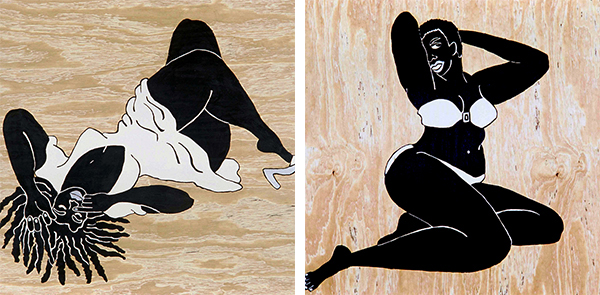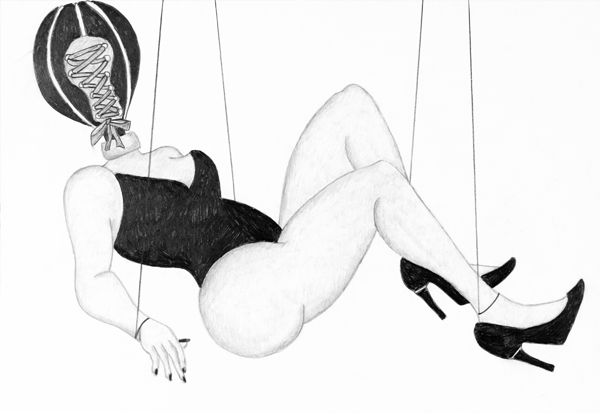By Sally Deskins
Wanda’s inspiration from pop art radiates in her pin-up prints. Transforming the kitschy source imagery of 1940s pin-ups, Wanda’s Black as Pitch, Hot as Hell series, explores how race informs society’s idea of female beauty. (Above: Wanda Ewing, Black as Pitch, Hot as Hell, 2006. Acrylic and latex paint on carved plywood. Right: Girl #2, 48″ x 48″. Left: Girl #6, 48″ x 48″.)
Along with Wanda’s subtle nods to hip-hop culture were her more direct critiques. Video Grrrlllz, a series of drawings inspired by video vixen Karrine Steffans, show barely-clad black women with punching bag-heads, a metaphor for how women have been treated in the hip-hop industry. The woman shown is strong, though pushed down, a commentary of the hip-hop industry which proved controversial, so much so that she was not accepted into a hip-hop exhibit due to the negative connotations. Her provocation was beyond her time and worth further examination, especially as it relates to the theme of misogyny in Hip Hop culture.
Like an artist she admired, Mickalene Thomas, Wanda appropriated art historical imagery, assessing contemporary society. In this early print below, Wanda parodied Manet’s Luncheon on the Grass, reversing roles by having two clothed black females and one nude, white male. They are having a picnic in a cemetery, a photo Wanda took in Paris, emitting a dark atmosphere.
In her referencing the rich symbolism of these art-historical influences we see Wanda’s attraction to them—the broad appeal of traditional printmaking, the use of satire to make social commentary and to critique representations of the body and specifically the black female body, in spoofing popular media and parodying art historical imagery. Wanda’s unique self-critique combined with her empowering figures presents a distinct perspective with plenty of room for further inquiry. I hope this provided an impetus into further examination and interest in Wanda’s work.
______________________________________________________________________________________
Sources
Personal interactions with Wanda Ewing, 2003-2013.
Biga, Leo Adam. “Wanda Ewing Exhibit: Bougie is as Bougie Does,” Leo Adam Biga Blog, 2013.
Bobo, Jacqueline. Black Feminist Cultural Criticism. Oxford: Blackwell Publishers, 2001.
Brand, Peggy Zeglin. “Feminist Art Epistemologies: Understanding Feminist Art,” Hypatia, Vol. 21, No. 3, Summer 2006 (166-189).
Buszek, Maria Elena. Pin-up Grrrls: Feminism, Sexuality, Popular Culture. Duke University Press Books, 2006.
Buszek, Maria. “Wanda Ewing: Self-Identity History: A Retrospective,” exhibition catalog, 2014.
Copeland, Huey. Bound to Appear: Art, Slavery, and the Site of Blackness in Multicultural America. Chicago: University of Chicago Press, 2014.
Fusco, Coco and Brian Wallis. Only Skin Deep: Changing Visions of the American Self. New York: Harry N. Abrams, Inc., Publishers, 2003.
Hutcheon, Linda. Irony’s Edge: The Theory and Politics of Irony. London: Taylor and Francis, 1994.
Gibson, Aliona. Growing up Black and Female in America. Writers and Readers Publishers, 1995.
Lanser, Susan. “The Living Handbook of Narratology.”
Lanser, S. (1986). Toward a Feminist Narratology. Style, 20(3), 341-363.
Maus, Derek. Post-Soul Satire: Black Identity After Civil Rights. University of Mississippi Press, 2014.
McQuiston, Liz. Suffragettes to She Devils. Phaidon Press, 1997.
Silva, Patricia. “Pin-Ups and Wallflowers,” Flare Arts Journal, 2015.
Wright, Beryl J. Lorna Simpson: For the Sake of the Viewer, University Publishing, New York, 1992.


